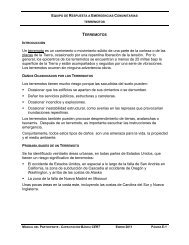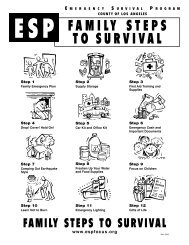Operation Control Dispatch Section - CERT Los Angeles
Operation Control Dispatch Section - CERT Los Angeles
Operation Control Dispatch Section - CERT Los Angeles
You also want an ePaper? Increase the reach of your titles
YUMPU automatically turns print PDFs into web optimized ePapers that Google loves.
year-old Linguistic Specialist from<br />
Colorado, who was chosen to<br />
serve as the automated dispatch<br />
voice of the LAFD. Ann-Marie will<br />
celebrate her virtual fifth<br />
anniversary with the LAFD in<br />
February, having worked 43,800<br />
OLD OCD<br />
continuous hours without a break.<br />
With the un-natural ability to<br />
communicate simultaneously with<br />
different messages to 32 different<br />
Fire Stations at any given moment,<br />
Ann-Marie (with more than a little<br />
help from Firefighter/<strong>Dispatch</strong>ers)<br />
alerted LAFD crews to 714,658<br />
responses last year alone, an<br />
average of 958 responses per day.<br />
While technology abounds at<br />
OCD, it takes highly trained<br />
personnel to use it. To begin the<br />
training, members must have a<br />
minimum of four years of field<br />
experience. Once selected for<br />
OCD training, members begin an<br />
arduous nine-week 40-hour-per<br />
week classroom training program.<br />
This training consists of learning<br />
the Department’s dispatch<br />
protocols, fire station locations,<br />
and specialty apparatus locations<br />
throughout the City. Following the<br />
classroom portion of the training,<br />
members are required to utilize<br />
their newly learned skills by<br />
working 20-24 hour shifts on the<br />
dispatch floor. Each of the newly<br />
<strong>Los</strong> <strong>Angeles</strong> Fire Department Newsletter<br />
trained dispatchers has an<br />
experienced dispatcher assigned<br />
to them as their trainer and mentor.<br />
Once the new dispatchers<br />
complete the more than 800 hours<br />
of training, they are ready to begin<br />
their new assignments as one of<br />
the 75<br />
LAFD<br />
<strong>Dispatch</strong>ers<br />
assigned to<br />
OCD. While<br />
headsetclad<br />
Firefighter/<br />
<strong>Dispatch</strong>ers<br />
are<br />
surrounded<br />
by high<br />
technology<br />
today, what<br />
got them<br />
there is an<br />
amazing<br />
story.<br />
LAFD’s<br />
RADIO<br />
SYSTEM<br />
In 1934, the<br />
<strong>Los</strong> <strong>Angeles</strong><br />
Fire<br />
Department<br />
installed <strong>Los</strong><br />
<strong>Angeles</strong> Police<br />
Department<br />
radio receivers<br />
and later<br />
transceivers<br />
exclusively in<br />
fire boats and<br />
Battalion<br />
Chiefs’ cars.<br />
While our Department continued to<br />
rely primarily on telephones and<br />
street-corner fire alarm boxes for<br />
field communications, the<br />
Westlake Signal Office on 6th<br />
Street near Alvarado, and the<br />
“Coldwater Signal Office” on<br />
Mulholland Drive, would often<br />
phone LAPD Communications<br />
when they had fires or other urgent<br />
messages for Battalion<br />
Commanders.<br />
WESTLAKE DISPATCHER AT WORK<br />
The actual fire calls were seldom<br />
broadcast over police radios as the<br />
Fire Department remained<br />
skeptical for years about the<br />
dependability of two-way radios.<br />
Instead, the Chiefs were simply<br />
told to “Phone Westlake (or<br />
Coldwater).” The Chiefs carried<br />
telephone handsets in their cars,<br />
and would stop at the nearest firealarm<br />
box, plug in, and receive<br />
their information from their<br />
respective Fire Department signal<br />
office.<br />
It wasn’t until 1946 that LAFD<br />
engines and trucks became<br />
equipped with two-way radios.<br />
Configured in the 33-MHz band,<br />
the frequencies from this original<br />
allocation were used into the late<br />
1980’s.<br />
Prior to modernization in 1972,<br />
LAFD dispatch operations were<br />
conducted manually in three<br />
separate locations throughout the<br />
City: Westlake, Coldwater and<br />
San Pedro Signal Offices. After a<br />
comprehensive study,<br />
consolidation of the three older<br />
dispatch sites into the new OCD in<br />
Level P-4 at City Hall East<br />
occurred. Implementation of the<br />
2




